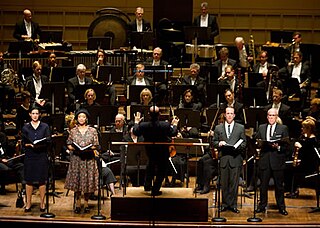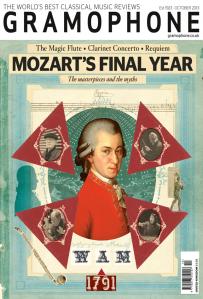
Bernard Johan Herman Haitink is a Dutch conductor.
Spirit Voices is a concerto for percussion and orchestra in seven movements by the American composer Steven Stucky. The work was jointly commissioned by the Singapore Symphony Orchestra and the Aspen Music Festival for percussionist Evelyn Glennie. It was first performed by soloist Evelyn Glennie the Singapore Symphony Orchestra under conductor Lan Shui November 14, 2003.
Emanations, also referred to by its original German title Emanationen or by its Polish title Emanacje, is a composition for two orchestras by Polish composer Krzysztof Penderecki. Composed in 1958, it is one of his early compositions.
Music for Orchestra is a one-movement orchestral composition by the American composer Jerry Goldsmith. The piece was commissioned by Leonard Slatkin and the St. Louis Symphony in 1970 and premiered later that year.
Heimdall's Trumpet is a concerto for trumpet and orchestra by the American composer Christopher Rouse. It was commissioned by the Chicago Symphony Orchestra for its principal trumpeter Christopher Martin. The piece was completed January 21, 2012 and premiered December 20, 2012 at Symphony Center in Chicago.
The Second Concerto for Orchestra is a concerto for orchestra by the American composer Steven Stucky. The work was commissioned by the Los Angeles Philharmonic while Stucky was their composer-in-residence for the inaugural season of the Walt Disney Concert Hall. It was completed in 2003 and was first performed on March 12, 2004, with the conductor Esa-Pekka Salonen leading the Los Angeles Philharmonic. The piece was awarded the 2005 Pulitzer Prize for Music.

August 4, 1964 is an oratorio for mezzo-soprano, soprano, tenor, baritone, choir, and orchestra written by the American composer Steven Stucky with a libretto by Gene Scheer. It was commissioned by the Dallas Symphony Orchestra in honor of the centennial of the birth of 36th U.S. President Lyndon B. Johnson. The piece premiered September 18, 2008 at the Morton H. Meyerson Symphony Center in Dallas, with conductor Jaap van Zweden leading mezzo-soprano Kelley O'Connor, soprano Laquita Mitchell, baritone Robert Orth, tenor Vale Rideout, the Dallas Symphony Chorus, and the Dallas Symphony Orchestra. The work specifically follows the events of August 4, 1964 during Johnson's presidency, including the Gulf of Tonkin incident and the discovered bodies of three murdered civil rights workers in Neshoba County, Mississippi.
Rhapsodies for Orchestra is a single-movement orchestral composition by the American composer Steven Stucky. The work was jointly commissioned by the New York Philharmonic and the BBC for the Philharmonic's European tour in August and September 2008. The piece had its world premiere August 28, 2008 in Royal Albert Hall at The Proms, with the New York Philharmonic performing under conductor Lorin Maazel.
Jeu de timbres is a single-movement orchestral composition by the American composer Steven Stucky. The work was commissioned by the National Symphony Orchestra and completed in late 2003. It was premiered in January 2004, with the National Symphony Orchestra performing under conductor Leonard Slatkin.
Son et lumière is a symphonic poem by the American composer Steven Stucky. It was commissioned by the Baltimore Symphony Orchestra and composed between June and December 1988. The work was premiered in Baltimore by the Baltimore Symphony Orchestra under conductor David Zinman, May 18, 1989.
Nyx is a symphonic poem by the Finnish composer Esa-Pekka Salonen. The work was jointly commissioned by Radio France, the Barbican Centre, the Atlanta Symphony Orchestra, Carnegie Hall, and the Finnish Broadcasting Company. It was premiered February 19, 2011 in the Théâtre du Châtelet, Paris, with Salonen conducting the Orchestre Philharmonique de Radio France. The piece is titled after the Goddess Nyx from Greek mythology.
The Stars and the Roses is a three-movement composition for tenor solo and orchestra set to the poetry of Czesław Miłosz by the American composer Steven Stucky. The work was commissioned by the Berkeley Symphony, for which Stucky was then composer-in-residence. It was first performed on March 28, 2013 by the tenor Noah Stewart and the Berkeley Symphony under the conductor Joana Carneiro. The work was rewritten by Stucky in a chamber arrangement of the piece that premiered on October 18, 2013 by the Curtis 20/21 Contemporary Music Ensemble and tenor Roy Hage. The piece is dedicated to Stucky's wife Kristen.
The Symphony No. 6 is an orchestral symphony in six movements by the American composer Howard Hanson. The work was commissioned by the New York Philharmonic under the direction of Leonard Bernstein for the orchestra's 125th anniversary. It was composed in 1967 and was given its world premiere on February 29, 1968, by the New York Philharmonic conducted by Hanson.
Old and Lost Rivers is a short orchestral composition by the American composer Tobias Picker. The work was commissioned to commemorate the sesquicentenary of Texas by the Houston Symphony, for which Picker had recently been appointed composer-in-residence. The work was composed in the spring of 1986 and was given its world premiere by the Houston Symphony under the conductor Sergiu Comissiona in Jones Hall, Houston on May 9, 1986. Later that year, Picker adapted the work for solo piano as a birthday present for the pianist Ursula Oppens; this rendition of the work was premiered by Oppens at Carnegie Hall in March 1987. The piece is dedicated to Stephen M. Aechternacht and is one of Picker's most frequently performed compositions.
The Concerto for Orchestra is an orchestral composition by the Finnish composer Magnus Lindberg. The work was commissioned by the BBC and was composed between 2002 and 2003. It was given its world premiere by the BBC Symphony Orchestra under the direction of Jukka-Pekka Saraste on September 30, 2003 at the Barbican Centre, London.
Dreamwaltzes is an orchestral composition by the American composer Steven Stucky. The work was commissioned by the Minnesota Orchestra for their annual Sommerfest series with support from the Jerome Foundation. The piece was completed in April 1986 and its world premiere was given by the Minnesota Orchestra under the direction of Leonard Slatkin on July 17, 1986. It is dedicated to the violinist Sonya Monosoff and Carl Pancaldo. The piece brought Stucky to prominence in the contemporary classical community and remains one of his most popular compositions.
Sculpture is an orchestral composition by the Finnish composer Magnus Lindberg. The music was commissioned by the Los Angeles Philharmonic with support from the Koussevitzky Music Foundation to celebrate the orchestra's inaugural season at the Walt Disney Concert Hall. Its world premiere was given by the Los Angeles Philharmonic under the direction of Esa-Pekka Salonen on October 6, 2005.
Still Life is a mural executed by Rufino Tamayo in 1954. It is on permanent display at the Museo Soumaya.Fundación Carlos Slim in Plaza Carso, Mexico City, Mexico.
A percussion concerto is a type of musical composition for a percussion soloist and a large ensemble, such as a concert band or orchestra. Two notable figures in the genre are the percussionists Colin Currie and Evelyn Glennie, who have separately commissioned and premiered numerous entrees to the repertoire. Two common subsets of the percussion concerto are the timpani concerto and the marimba concerto.








